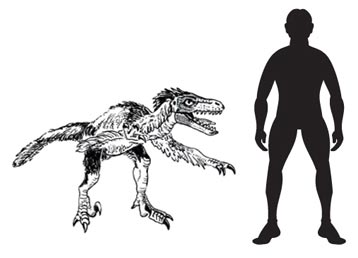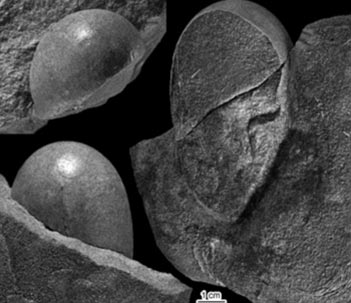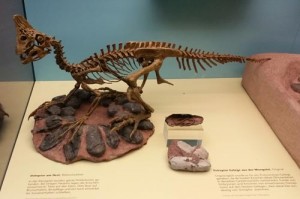Theropod Eggs Correlate Directly with Modern Bird Eggs According to New Study
Spanish Fossilised Eggs show Strong Link between Theropoda and Aves
Palaeontologists have been aware for some time, of the close anatomical links between certain members of the lizard-hipped dinosaurs known as the Theropoda and modern birds. A great deal of evidence has been compiled to show that certain types of dinosaur such as the Dromaeosauridae, the raptors, were closely related to Aves (birds). Scientists know for example, that many small, meat-eating theropods such as members of the Dromaeosauridae, dinosaurs such as Microraptor and Sinornithosaurus were covered in feathers, but there are also striking similarities between the skeletons of birds and the fossilised bones of these types of dinosaur. New research suggests that theropod eggs were extremely similar to modern bird eggs.
Some Types of Dinosaur were Feathered
Picture credit: Everything Dinosaur
Dinosaurs and Birds
The link between dinosaurs and birds is not a new theory in palaeontology. Granted, there have been a number of startling discoveries made of feathered dinosaurs, most notably in the Lower Cretaceous strata of Liaoning Province (northern China). It was the likes of Thomas Henry Huxley who first proposed the dinosaur/bird link.
Thomas Henry Huxley was an English biologist and an ardent supporter of Darwinism. When Sir Richard Owen purchased a nearly complete specimen of Archaeopteryx (A. lithographica) in the 1860s, Huxley used this fossil to support Darwin’s theory of natural selection and declared the Archaeopteryx specimen as a “transitional fossil” between reptiles and the evolution of birds.
However, one of the gaps in our knowledge regarding the relationship between certain members of the Dinosauria and the Order Aves, concerned the shape and composition of the eggs that these types of creatures laid. A number of different shapes and sizes of dinosaur egg are known from the fossil record, but those fossil eggs ascribed to theropods do not closely resemble the shape of a modern bird’s egg such as the type of egg that a chicken would lay. Typically, a small-meat eating dinosaur might produce relatively elongated eggs, not the ovoid shape that we are used to when we see a bird’s egg.
The discovery of the remains of dinosaur eggs in north-eastern Spain may change all that, as these eggs do resemble those of a modern bird.
Theropod Eggs
Nieves Lopez Martinez, a palaeontologist at the Complutense University of Madrid (Spain), with a doctorate in geology and biology, had been researching into the strange, ovoid and asymmetrical fossil eggs that had been found in the Montsec area of Lleida in north-eastern Spain. Sadly, she passed away in December 2010. Her work and that of her colleague Enric Vicens, a palaeontologist at the Universitat Autonoma de Barcelona (Spain), has just been published. Their extensive research provides strong evidence linking theropod dinosaurs to modern birds, as the eggs found in Spain are very similar in shape and composition to those of extant birds.
The eggs were excavated from two dig sites, located on either side of the Terradets pass. The strata in this part of Spain represents sediments laid down at the very end of the Cretaceous (Campanian and Maastrichtian faunal stages). A number of different types of dinosaur are known from this strata – ornithopods, theropods and titanosaurs. The geological record in this part of Spain is very important, as it is providing scientists with an insight into the flora and fauna that existed in Europe at the very end of the Age of Dinosaurs.
To read an article about “giant dinosaur eggs” being discovered: World’s Largest Dinosaur Eggs – The Facts are Scrambled.
Although, the scientists cannot determine exactly what sort of dinosaur laid the eggs, they have postulated that they were produced by a troodontid a type of dinosaur, closely related to birds. Troodonts were small, agile, bipedal predators. The egg fossils, which consist of many fragments plus some complete eggs have been given the scientific name of Sankofa pyrenaica. The genus name relates to an ancient bird symbol which shows a bird looking over its back with an egg that has just dropped from its mouth. The species name relates to the fact that the fossils were found in a part of the southern Pyrenees mountain chain.
Some of the Fossilised Dinosaur Eggs (S. pyrenaica)
Approximately seventy million years ago, this part of Spain was a low-lying coastal zone with many shallow lagoons that were bordered by lush, dense forests. A number of fossils of dinosaur eggs have been found in this area, it seems that a number of different types of dinosaur laid eggs on the raised beaches that made up this coastal zone, but most of the fossil eggs found to date are large, rounded Titanosaur eggs. These eggs are very different, measuring just seven centimetres high and with a diameter of approximately four centimetres. The eggshell is roughly the same thickness of that of a hen’s egg. The scientists measured the fossilised eggshell and found it to be around 0.27 mm thick.
Sectional Analysis of Theropod Eggs
Sectional analysis of those eggs that had been preserved intact showed that at the wider end of the egg there was a substantial air pocket. Such air pockets are found in modern bird eggs. If you take a hen’s egg and place it in water, a fresh egg will sink but it will have a degree of buoyancy. The buoyancy is provided by a small air space contained within the egg. The pocket of air allows the organism inside the egg to breathe during the last phases of its development prior to hatching.
Such oval-shaped, asymmetrical eggs are extremely rare in the Cretaceous fossil record. The Spanish researchers related the shape of their eggs to that of a Late Cretaceous bird whose fossils have been found in South America. The research team postulated that this bird and their dinosaur both laid eggs that were intermediate between modern bird eggs and those eggs laid by extinct non-avian theropods.
A microscopic analysis of the fossil eggshell of Sankofa pyrenaica did reveal significant differences in the shell structure when compared to that of a modern bird’s egg. Bird and most reptile eggshell is composed almost entirely of calcium carbonate, the structure of the crystals and how they are organised in a bird’s egg differs from that seen in the internal structure of the eggshell ascribed to S. pyrnenaica.
The shape of an egg is dictated largely by the physiology of the organism that lays those eggs. Asymmetry in bird eggs relates to the fact that birds only have one oviduct, they can only form one egg at a time as a result. Most dinosaur nests show that eggs were laid in pairs, indicating that these animals had two oviducts. Scientists believe that modern birds lost the second oviduct as an evolutionary response to the need to lighten their bodies so as to make powered flight more efficient. The asymmetrical shape of the Spanish dinosaur eggs suggest that Sankofa pyrenaica also possessed just a single oviduct.
A Dinosaur Nest (Eggs Laid in Pairs)
Picture credit: Everything Dinosaur.
This fossil evidence strongly supports the theory that certain clades of dinosaur were indeed very closely related to birds. Parts of the Dinosauria and Aves are very closely phylogenetically related.
Extrapolating this evidence, the next time you eat a boiled egg you are technically eating the egg of a creature very closely related to a dinosaur – or given the location where these fossil eggs were found, would you prefer a Spanish omelette?
Visit Everything Dinosaur: Our Award-winning Website.




